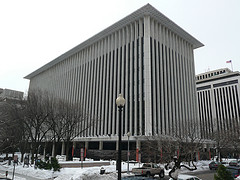The Urban Green Council is the NYC Chapter of the US Green Building Council. The New York City folks are very active, extremely creative and progressive, and forging true global leadership in green building and design. I attended their inaugural Urban Green Expo last year, and went again this year. The theme this year of “pushing the envelope” was highlighted by a number of speakers, in presentations, and at the expo booths with a focus on high-performance buildings and innovation in new and rehabbed buildings, processes and systems.
The educational sessions are a particularly great aspect of this two-day event. I sat in on a panel discussing how the National Geographic Society is working toward a zero-carbon footprint at its four-building complex in Washington, DC and for its 1,700 staffers. Driven largely by a volunteer committee led by Hans Wegner, the world famous magazine’s VP for production services, they have carved out some significant savings in energy, money and carbon output. They have become one of EPA’s “Climate Leaders” in their quest for a zero carbon footprint. The magazine has for a number of years been a leading voice in environmental protection and sustainability. Wegner wanted the NGS itself to be as green as the magazine’s editorial policies and coverage.
One of their initiatives was to bring in a cutting-edge consultant, Terrapin Bright Green, to help figure out the best ways to reduce the buildings’ carbon output. Bill Browning, one of Terrapin’s founders, explained that one thing they found right away was an insanely inefficient AC system for the Edward Durrell Stone building that was on all the time – and then used gas heat to moderate the temperature when needed.  Needless to say, they fixed that and are also rolling out other highly cost-effective measures. However, after all is said and done, in order to get to zero carbon, they still need to find some way to offset the remaining natural gas in use.
Needless to say, they fixed that and are also rolling out other highly cost-effective measures. However, after all is said and done, in order to get to zero carbon, they still need to find some way to offset the remaining natural gas in use.
Terrapin is helping to develop a new sustainability strategy: engaged offsets. Not only do these offsets serve the critical function of mitigating greenhouse gas output to the climate system, but they also help finance important objectives such as supporting affordable housing. Terrapin is working now with several major banks to develop a bond instrument that bundles these offsets to help finance renewables for low-income housing.
Another panel I attended was on the smart grid, perhaps the key enabling technology – really a suite of technologies – for a global renewable energy economy. The panel was led by the CEO of Viridity Energy, one of a slew of key players in this rapidly burgeoning field. (I’ve been a big fan of the smart grid since I wrote an article for the American Planning Association on its critical importance and potential.)
She – the head of Viridity – had a number of points to make, including the idea that the smart grid is creating a new actor in the energy economy: the “prosumer” – the consumer who is also producing their own power and selling the excess back to the grid. Another critical aspect of the smart grid is that you can optimize existing energy resources, thereby avoiding the costs of building new resources and operating very expensive peak power plants, so energy use becomes much more environmental and economic. Other panelists included folks from Con Edison, the NYC Economic Development Corp., FERC and Columbia University.
One of the key components of the smart grid and also one of its principal raisons d’être is its enhanced ability to manage demand. One of the best sources on the smart grid – if not the best – is the excellent Smart Grid News. Their compilation of articles here on demand side management says that “Because demand side changes are typically less expensive and less time consuming than building new power plants, this sector is seeing explosive growth.”
I was also fascinated by the session on geothermal applications in an urban environment. The 100 projects in the five boroughs of New York City do not rely on the heat generated from the earth’s core, as utility-grade installations like the Geysers complex in California does. We benefit in the urban environment rather from the energy stored by the earth from solar radiation. These installations are called geothermal heat pumps or ground-source heat pumps.
Globally, there are over 130 million pumps in residential buildings and another 15 million in commercial buildings, saving 1.2% of global CO2 emissions annually, according to a report from the International Energy Agency’s Heat Pump Program. The potential is even greater: 50% of the building sector and 5% of the industrial sector’s emissions could be eliminated by heat pumps. That’s 1.8 billion tons of CO2 a year – 8% of the total global output. Although this is still a technology in its relative infancy for urban applications, the expert panelists were all very involved in rapidly and broadly ramping up its use in cities.
Last year’s keynote speaker was Amory Lovins. His talk was a blockbuster. This year they had Bill McDonough, visionary architect and, like Lovins, a true sustainability mahaguru. I’ll have a lot to say about McDonough and his talk next week. For now, here’s the title of his talk: Cradle to Cradle Design – Moving from Less Bad to More Good.